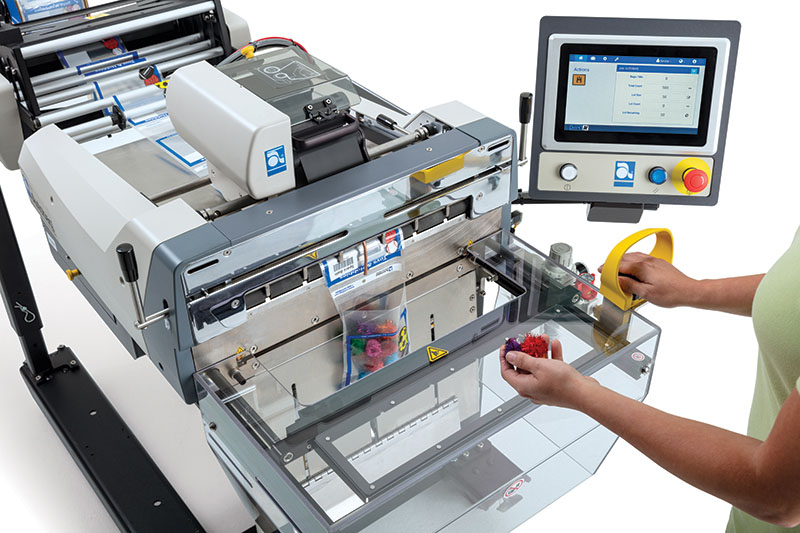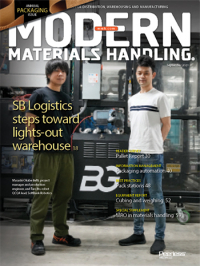Packaging automation as a bottleneck buster
By deploying automated packaging solutions, operations can significantly reduce the labor needed compared to manual pack out. It’s about ensuring high and reliable throughput and reducing the worries of scaling up labor to handle peak seasons, while minimizing dim weight charges with package right-sizing.
Carrier cut-off time. That short phrase is enough to get many DC managers nervous, especially if they run a fulfillment center that ships out hundreds or thousands of e-commerce orders per shift.
Short of outbound dock management, the nearest and biggest potential bottleneck area that can play havoc with meeting those cut-off times is pack out. That’s why automating the packaging of e-commerce orders is an area of growing interest, because if automation can process hundreds of orders per hour—creating right-sized parcels in the process—pack out promises to become a source of reliable throughput, rather than one of angst.
“In the current environment, we’ve seen some really large increases in e-commerce, so these companies with fulfillment center operations are having a real difficult time keeping up with all those orders,” says Sean Webb, director of automated packaging solutions at Quadient, which offers various automated packaging solutions. “That’s why the drivers for automated packaging start around labor, as it’s the single biggest hurdle we hear from our customers right now.”
Other reasons for deploying automated packaging solutions include “right-sizing” cartons to hold down carrier charges. Since 2014, rather than charging based just on weight, carriers have used a pricing structure that factors in package dimensions (known as “dim” weight pricing) so more parcels can fit into one truck. That puts the onus on fulfillment centers to fit the items in a customer order into the most compact carton or bag. Many operations try to do that by stocking manual pack out areas with different sizes of stock cartons, but today’s automated packaging solutions have equipment that creates a custom-sized box that precisely matches the combined volume or “cube” of the items in an order, holding down freight charges and minimizing the carbon impacts of e-commerce shipping.
On the labor front, packaging automation is not so much a matter of wanting to eliminate a handful of positions, explains Webb, but rather eliminating the mad scramble of trying to find enough people to package shipments during busy times.
“You can’t just throw more labor at the problem, because finding that labor is so difficult,” says Webb. “If an operation [with manual packaging] starts to see significant increases in demand, they’re going to have real problems if they don’t have an automated solution or combination of automated solutions that bring your labor force to that needed productivity level.”
Labor as bottleneck
Quadient figures an automated packaging solution like its CVP model can reduce the labor requirement in a pack out operation by an average of 88%. Put another way, explains Webb, one automated packaging line can replace eight to 20 workers doing manual pack out, though the exact level of labor savings will depend on how efficient the operation was beforehand and whether or not it had some level of automated equipment in packing, like automated carton sealers.
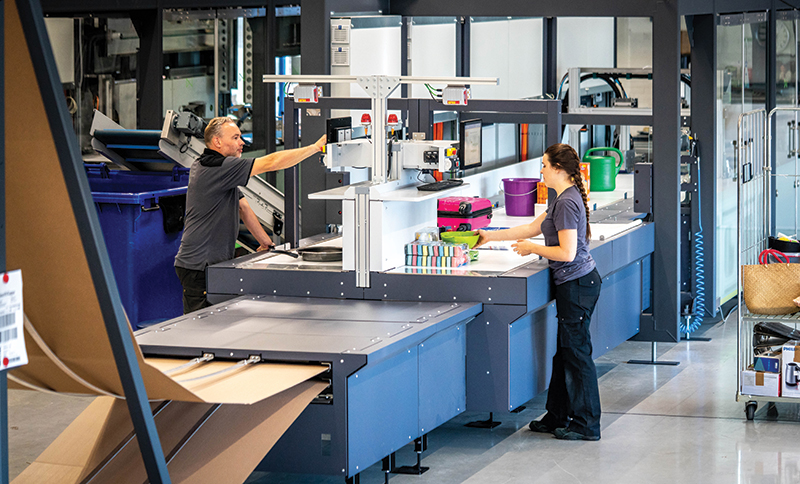
So, while automation offers the opportunity to reduce headcount in pack out, the bigger benefit is eliminating the potential bottleneck of not being able to easily add more people to ramp up throughput during peak times. With an automated packaging solution, you typically have some human labor, but the tasks are greatly reduced.
They are basically doing a scan verification to induct order items into the automated line, at which point the automation takes care of the other steps like scanning the goods for accurate dimensions, creating a right-fit custom carton, and automating other functions like sealing and weighing. Some solutions incorporate freight rating software.
“The basis return on investment [ROI] for our packaging solutions often start with the labor productivity benefits, but the savings on freight and materials are also important areas of payback, since these are integrated solutions that create a custom-fit parcel, which saves on materials and shipping charges,” says Webb. “A right-fit, automated solution also tends to save space for the DC, since you don’t need to position different sized boxes and void fill materials like you would in a manual packing area. But there’s no question that labor productivity is a key driver for our solutions. With an automated packaging solution, you can process a lot more packages with far fewer people.”
One user of Quadient’s CVP solution is Powertool World, one of the largest tool distributors in the United Kingdom. By deploying one CVP, which can process 450 single or multi-item orders an hour, Powertool World eliminated eight to 16 packing stations and the scramble to find enough labor.
“Finding staff for our busy packaging and dispatch operations was becoming increasingly difficult, particularly during peak periods. Investing in the CVP automated packaging solution has reduced the strain of hiring extra staff and given us the ability to meet both our projected growth targets and peak periods while maintaining and developing our customer service offerings,” says Chris Guy, founder and managing director of the Powertool World.
Automated order packing has some important hardware elements, but solution providers typically offer software, not only to trigger the automated elements, but to perform functions like cartonization to determine how items can be packed to ship in the smallest possible carton or package.
Cartonization logic about which items are best to release in a wave of work supports efficient packaging, says Dan Hanrahan, CEO of Numina Group, a warehouse automation solution provider. Using software rules about “pack classes,” packaging efficiencies often start at the order release process prior to beginning the picking operation, he explains.
“You need to holistically consider the entire pick, pack and ship processes to drive efficiency at packing as a component complete process,” says Hanrahan. “In the order release process, the system can look at orders to identify ways to reduce touches and gain efficiencies in packing.”
Numina Group’s RDS software, for instance, has a concept known as “pack class,” which keeps track of which items, for instance shirts, that ship in the same type or size of polybag or carton. The software can then release work so those items can be batch picked together and consolidated into the same tote and routed to the appropriate packaging line or station.
For example, if 10 different orders are for shirts, and are single-item orders, packaging efficiencies can be found in releasing, picking, routing and processing those orders as a group. “In some cases, significant productivity gains can be made in packing by how your release orders to create uniform, efficient work at pack out,” says Hanrahan.
Likewise, cartonization logic in warehouse management system (WMS) or warehouse execution system (WES) software is important for packaging efficiencies, because it determines the right sized carton or cartons. Packaging solution vendors use similar logic to support on-demand creation of right-sized boxes. Cartonization is also useful for allowing an operation to pick items straight into an appropriately sized shipping carton, which is increasingly being done in pick-to-cart workflows or picking workflows assisted by autonomous mobile robots (AMRs), says Hanrahan.
Picking directly to the shipping carton minimizes touches at pack out, explains Hanrahan. A packer may still need to add a packing slip or other documentation, seal the package, and capture final weight if these steps aren’t automated as part of an in-line solution, but they are no longer dealing with selecting, erecting or replenishing cartons. “If you can drive an efficient process for the operator with fewer touches, then they can focus on those final value-added tasks,” Hanrahan says. “Cartonization is a critical element to driving packaging efficiencies.”
While some operations might benefit from a fully automated packaging line, gains can also be made through partial automation, says Hanrahan, such as adding carton erector equipment or adding automated carton sealers to create semi-
automated pack out stations.
There’s also on-demand printing and inserting equipment for documents like packing slips. Paired with software that handles aspects like cartonization, productivity gains can be made by automating select parts of the pack out process, Hanrahan points out. “You can put in technology that works fast, takes touches out, and performs some key tasks automatically,” he says.
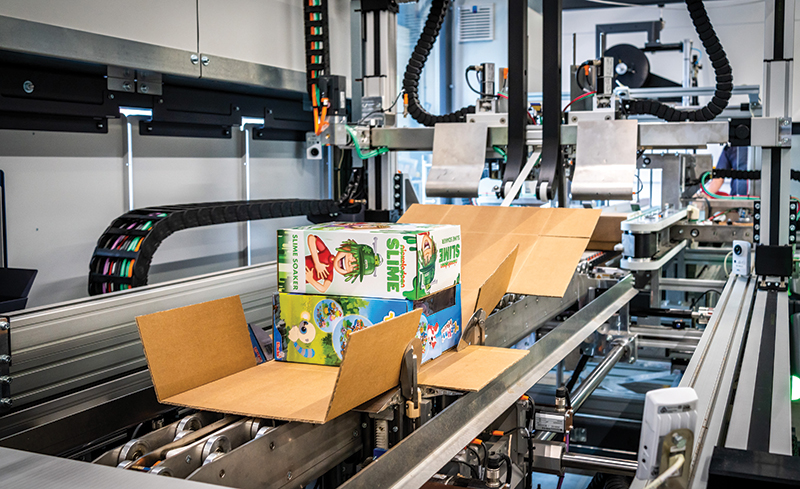
Scoping solutions
Effective packaging automation relies on capable software, not only for cubing and package right-sizing, but so orders are routed to the most appropriate packaging line or station, since some larger operations may have more than one automated packing area, notes Connor Pehrson, director of product management for Packsize, a supplier known for its “on-demand” packaging solutions.
While on-demand, right-sized carton creation is a core competency for Packsize, its solution relies on software to get order level detail from the WMS, route goods to the right packing lines, and other functions that orchestrate packaging activity. “What we offer is more of a solution set, rather than a single technology,” Pehrson says.
Packsize’s PackNet software, for instance, has logic that routes orders to the best available line based on factors such as cut off times, how busy a site’s packaging lines are, whether a line is low on corrugate, as well as congestion in other systems like conveyor. “Perhaps the most important element of a solution is its data management capabilities and how the software handles the routing of specific orders,” Pehrson says. “You want to be able to optimize the routing of where the packaging happens, to hit cut off times, while also making the most efficient use of available resources and ensuring orders go out in right-sized packages.”
Some facilities may decide to deploy more than one automated packaging line, or have one highly automated line, and others with less highly automated set-ups, but still with package right-sizing. Scoping which solution or mix of solutions best matches an operation’s current and future plans is a matter of analyzing order volume and working with operations managers to understand their needs, Pehrson says.
“Figuring out the best solution really starts with establishing a strong relationship with the customer, because every customer, or even site, is on its own journey,” Pehrson says. “We step back and analyze what the customer’s goals are, what their throughput needs are now and in the future, and come to the table with the right level of solution for them. We also work closely with any key integrators for other types of automation like conveyor, because we need to know the requirements of those systems as well.”
Packsize can work with different material flows and methods, including a “box first” approach or a “box last” method. Like the name implies, Pehrson says, box first centers on creating a right-sized box for the cubic volume of the order, then routing it to needed pick locations and picking to it, with final packaging steps occurring later.
In box last, completed orders are brought to the packaging automation, where the right-sized boxes are created, and other automated packaging steps take place. Some facilities like the speed of box-last, while others like the simplicity and fewer touches (and less need for totes) of box first, and both methods are supported by Packsize, adds Pehrson.
Stepping in
For most fulfillment operations with significant e-commerce to support, typically some level of automated packaging equipment can be justified. Don’t assume automated packaging solutions are out of reach, since vendors offer a range of options.
You can think of packaging solutions as being on a continuum from lower cost equipment that can make work at manual pack stations more efficient and easier to manage, to a middle tier of semi-automated solutions, to fully automated, in-line solutions, points out Scott Keefauver, fulfillment marketing director for Sealed Air, which offers solutions across this range. For example, at the simplest end of the range is equipment such as machines that inflate bubble wrap on demand from flat-roll stock, which reduces space needs and clutter at work cells.
In the middle of spectrum are solutions that automate select tasks at the work cell level, such as Sealed Air’s Autobag lineup of automatic bagging systems that perform filling and sealing of polybags.
At the upper end are fully automated in-line solutions that do carton forming and right-sizing, as well as more highly automated bagging lines that integrate with inline printers, counters, scales and conveyors. Some fulfillment centers will mix solutions, and even facilities with fully automated lines will typically maintain some more manual pack stations for non-conveyables or other items.
What if sensing could see inside the box?
While many cubing and dimensioning equipment choices out there can collect dimensional data, a new type of sensing technology can see and inspect through corrugate, plastics and packaging to do things like gauge how high the cube utilization is on shipping cartons, detect liquid leaks in outbound packages, or verify item counts. Known as 3D millimeter (mm) Wave sensing, the technology was introduced last year by ThruWave.
According to Pieter Krynauw, ThruWave’s CEO, 3D mm Wave sensing can see through sealed packages, which enables the technology to serve as an accurate measure of how much of a package’s cube is taken up by ordered items, and how much is wasted space.
The technology has not been deployed yet as an “in-line” element of automated packaging lines for e-commerce, but ThruWave has been working with end user organizations to use the imaging to gauge how effective the cube utilization is with their current manual or semi-
automated pack out stations.
“What we’ve seen with some of our customers is that although they’re doing dimensioning, the master data may not be high quality, so even though they think they should be packing out at a certain fill fraction of the carton volume, it ends up being something completely different,” says Krynauw. “Our technology can provide that closed-loop, real-time feedback in terms of the actual cube utilization, to give them the necessary data to see what needs to be improved in terms of master data, or to see if an automated packaging solution is needed and the improvement level that could be achieved.”
Krynauw says an operation could use ThruWave’s sensing to detect leaks from shipments before they leave a facility or to ensure the item count is correct. Another use of the technology for cube utilization is to use the sensing to analyze cube utilization within the bins of automated storage and retrieval systems (AS/RS) to help gauge if the inventory or replenishment rules should be tweaked to achieve more dense storage.
“We can provide insight that can help make a more informed decision on automated packaging solution, and then, if a customer decides to put in an automated solution, I think we can add value by being on the front end of that or on the back end, to see what is actually happening, and help determine if the system needs to be fine-tuned,” Krynauw concludes.
Some DCs undertake a packing efficiency “journey,” Keefauver says, in that they start with equipment that gives them more efficiency at the work cell level, then add some semi-automated work cell solutions, and later deploy fully automated lines. “That’s the kind of journey we see some operations take, though often, we’ll be able to walk into a DC environment, do an assessment and be able put those types of combinations together from the start,” Keefauver says. “Every fulfillment operation is different, their space needs are different, their volumes and volume surges will differ, but with a full portfolio of solutions, we can match a solution to them.”
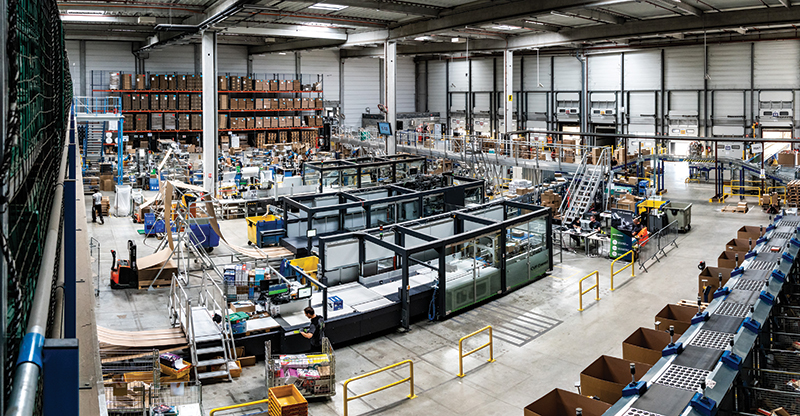
Even at the middle tier of solutions, significant gains in throughput can be made. In a manual work cell environment, assuming a consistent flow of orders and a ready supply of packing materials, a good operator might pack three or four orders per minute. But with an auto-bagging machine, the output in practice ranges from five to eight completed orders per minute, even though the auto-bagger has a higher theoretical output, says Keefauver. “You can essentially double the output with a semi-automated solution, and a really efficient operation can probably go even a bit higher,” he adds.
For Fanatics, an online retailer of sports fan merchandise, the move to semi-automated packing stations equipped with Sealed Air’s Autobag machines (initially, four 850S machines), has brought a five times improvement in pack out efficiency and throughput versus manual pack out stations used previously. The deployment is also credited with giving Fanatics the ability to scale fulfillment operations to accommodate peak season and changes in demand.
There are caveats with the output that can be achieved with packaging solutions. With semi-automated stations, some operations will have more scan verification or other quality control steps, or the operator has to manually apply a shipping label or do other tasks like insert catalogs. Even with fully-automated solutions, you need a steady flow of orders routed to the correct packing locations at the right times to meet cut-off times. That said, given the growth curve for e-commerce, more sites will likely turn to packaging automation.
As Keefauver explains: “The thing to keep in mind is that today, roughly 20% of retail and consumer goods type sales are through e-commerce channels, and e-commerce is just continuing to grow and grow. So, you either try to continue packaging with a manual, labor intensive approach, at a time of very limited labor resources, with costs going up for labor, or you bring in some automation, which is also going to help with right-sizing and freight costs. Packaging automation is a way to manage that growth in e-commerce fulfillment.”

Article Topics
Packaging News & Resources
Registration open for Pack Expo International 2024 Pack Expo East has largest show to date Optimize Parcel Packing to Reduce Costs CMC Packaging Automation North America unveils Tech Center in Atlanta PACK EXPO East brings latest packaging technologies to Philadelphia Loftware’s cloud-based labeling solutions take center stage Flexcon unveils its innovative bin solutions More PackagingLatest in Materials Handling
Beckhoff USA opens new office in Austin, Texas Manhattan Associates selects TeamViewer as partner for warehouse vision picking ASME Foundation wins grant for technical workforce development The (Not So) Secret Weapons: How Key Cabinets and Asset Management Lockers Are Changing Supply Chain Operations MODEX C-Suite Interview with Harold Vanasse: The perfect blend of automation and sustainability Consultant and industry leader John M. Hill passes on at age 86 Registration open for Pack Expo International 2024 More Materials HandlingAbout the Author
Subscribe to Materials Handling Magazine

Find out what the world's most innovative companies are doing to improve productivity in their plants and distribution centers.
Start your FREE subscription today.
April 2024 Modern Materials Handling

Latest Resources


